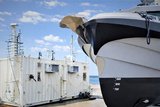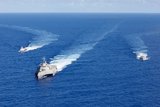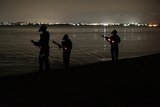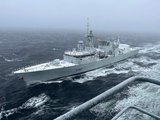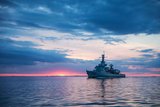CAES awarded $200 million contract to provide USN with large ship radar modules
Arleigh Burke-class Flight III ship USS Jack H Lucas is one of the USN's fleet fitted with AN/SPY-6 radars. (Photo: HII)
The contract is for follow-on, full-rate hardware production and sustainment and CAES will provide fully tested radar module assemblies for the USN’s AN/SPY-6 family of radars.
CAES has been a multi-year partner with Raytheon on the SPY-6 programme and has already begun delivering hardware.
According to CAES: ‘This follow-on, multi-year award demonstrates the continued, strong partnership between CAES and Raytheon, and our demonstrated capacity to provide the SPY-6 radar with reliable components and meet the USN fleet’s needs for many years to come.’
Related Articles
Raytheon progresses AN/SPY-6 efforts
SPY-6 can defend against ballistic missiles, cruise missiles, hostile aircraft and surface ships simultaneously and offers several advantages over legacy radars, such as greater detection range, increased sensitivity and more accurate discrimination.
Raytheon has developed four variants of the AN/SPY-6 using a scalable design, beginning with the AN/SPY-6(V)1 for Flight III Arleigh Burke-class destroyers. This radar features four array faces with 37 Radar Modular Assemblies (RMAs) apiece.
The second, AN/SPY-6(V)2 or EASR (rotor variant), designed for LPDs and the Nimitz-class aircraft carriers, features one rotating array face with nine RMAs.
AN/SPY-6(V)3 or EASR (fixed variant), designed for the Ford-class carriers and future Constellation-class frigate, comprises three fixed array faces, each with nine RMAs and offers air traffic control capabilities.
AN/SPY-6(V)4, designed to be retrofitted to the Flight IIA Arleigh Burke-class destroyers, features four array faces, each with 24 RMAs.
Related Equipment in Defence Insight
More from Naval Warfare
-
![Maritime defence in the Mediterranean faces challenges from vulnerable land power]()
Maritime defence in the Mediterranean faces challenges from vulnerable land power
As an indispensable energy crossroads, the Mediterranean is at serious risk from grey zone disruption. As navies increasingly employ AI data centres, what happens when cutting-edge defence technologies rely on the very infrastructure most susceptible to hybrid tactics?
-
![Future Canadian Continental Defence Corvette will provide “Halifax-equivalent capabilities”]()
Future Canadian Continental Defence Corvette will provide “Halifax-equivalent capabilities”
Although the CDC project is still in its early stages, the Canadian Department of National Defence already has some requirements for the future platforms.
-
![NATO tests use of “undetectable, jam-proof” laser communication in maritime scenarios]()
NATO tests use of “undetectable, jam-proof” laser communication in maritime scenarios
As part of its effort to better prepare its capabilities for operations in contested and congested scenarios, NATO evaluated a Lithuanian ship-to-ship terminal designed to not be susceptible to enemy interference.







